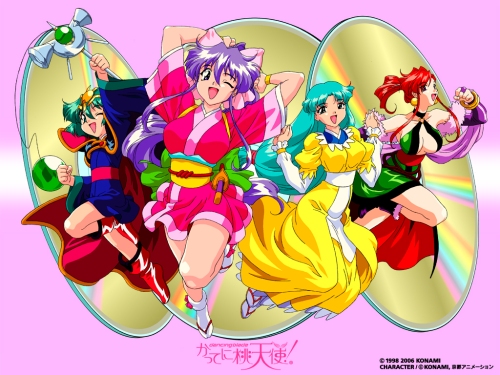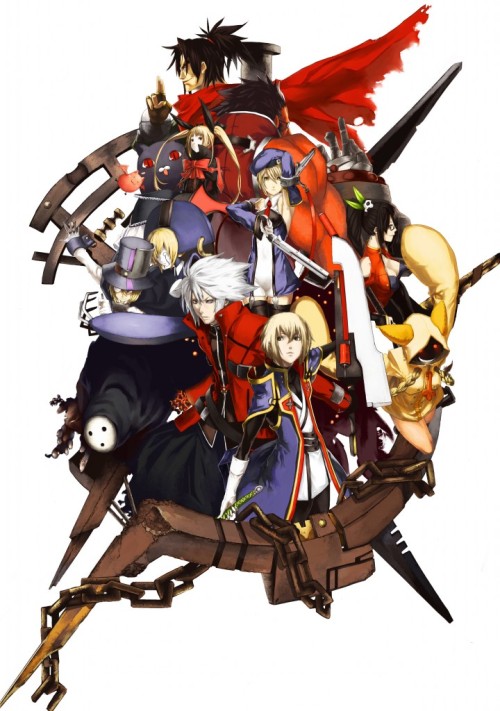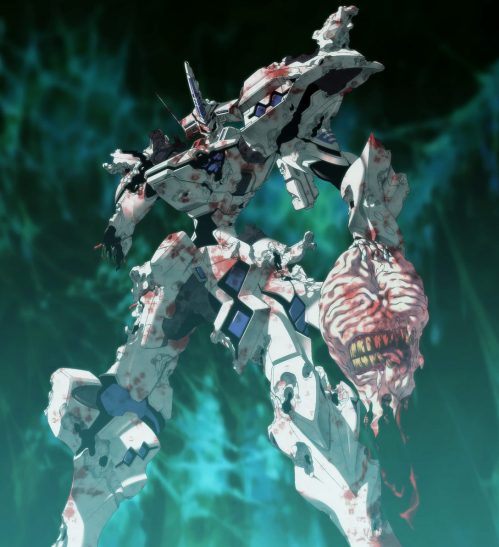I guess it’s time for some words on Hiroyuki Kitakubo considering how much buzz he created recently. Ever since he opened his twitter account he and his tweets have become a regular topic on 2channel’s sakuga thread as he sure talks about interesting stuff. However, as person he strikes me as a bit arrogant and self-aggrandizing, at least judging by his tweets and messages I’ve exchanged with him. Since he’s following me on twitter and he doesn’t want me to make ‘advertisement’ for this Malaysian ‘shit anime’, I refrained from posting a direct link to here. Yeah, you read correctly, he’s hardly enthusiastic about this TV anime, but it’s somewhat understandable. He’s a director that always tries to gather the best people and who values talented staff above all, and now he has to work on a series for Malaysian kids which is produced in Malaysia, Philippines and China. I mean, he’s a high-profile director who won awards at Animation Kobe and Japan Media Arts Festival and now he has to work on this. As opposed to some news on the web he said he didn’t direct this anime, but had just an adviser role and he would protest at GONZO for this incorrect information. It’s obviously a job he doesn’t want to be associated with and also a job he doesn’t want to do but has to due to his financial situation or whatever, so it’s better to expect nothing of this. Yet what really bugs me is that ‘Satria – The Warriors of the 7 Elements’ is slated for Fall 2012 – that’s almost two years away. I hope this is not the only thing he works on in this period. However, I somehow suspect this could be the case since finding other work might also be pretty tough for him. Ever since he directed ‘BLOOD’, he hasn’t done much other notable work. There has been much speculation about the reasons, for example that he was fired from Production I.G. some time after ‘BLOOD’ (which makes sense since he’s never worked again there ever since). And he seems to have blown it with many other studios as well probably due to his slightly bad character. And there’s also a rumor that he was involved with the drugs scene back in 2006 and thus has now a hard time to find a job, but take this with a big grain of salt.
(more…)
Archive for the ‘Game’ Category
Satria, Hiroyuki Kitakubo & stuff
Posted in Animation, Animator, Game on October 26, 2010| 1 Comment »
Must-watch animated game openings: Part 3
Posted in Animation, Animator, Game on December 1, 2009| 2 Comments »
Kinpachi-sensei Intro (2004)
This nice sequence serves as the intro for the 2004 PS2 game with the extra-long title “San nen B-gumi Kinpachi-sensei densetsu no kyoudan ni tate!”, which was produced by Chunsoft who got recently some attention for their visual novel “428: Fūsa Sareta Shibuya de” and its anime spin-off “Canaan”. I especially like the calm mood of this opening sequence which was realized with a good sense for depicting everyday (school) life in a believable way, something I would like to see more often in anime. It abandons the typical anime depiction of school life by choosing a more realistic and mature approach that makes it feel similar to Ghibli works, it even has some funny scenes which establish some kind of light-hearted mood. The “Ghibli feel” is of course not a coincidence as many of the artists responsible for the Kinpachi-sensei OP worked on Ghibli works and also on “World Masterpiece Theater” series, ranging from the character designer and layout designer Satoko Morikawa (who did the same work on “The Cat Returns”) to Ei Inoue and Kazutaka Ozaki (who were animation directors of said Ghibli movie) to other talented artists like Telecom animator Hiroyuki Aoyama (animation director of Tokikake and Summer Wars). The opening is consequently full of refined character animation and different from most other game openings, they even animated it at 30 frames per second instead of the usual 24 frames what leads to a distinctive and even more realistic feel.
Character Design / Layout: Satoko Morikawa
Chief Animation Director / Character Key Animation: Ei Inoue
Animation Director / Key Animation: Kazutaka Ozaki
Director: Koujirou Tsuruoka
Storyboard / Key Animation: Hiroyuki Aoyama, Naoki Arakawa, Masahiro Kurio, Jun Uemura, Akiko Yamaguchi
Animation Check / Key Animation: Yasuko Miyazaki
Key Animation: Atsushi Sekiguchi, Takayo Nishimura, Miwa Sasaki, Katsu Oushiro, Yumi Chiba
Magical Girl Pretty Sammy Music Clip (1998)
This one is an animated bonus music clip from the Sega Saturn game “Magical Girl Pretty Sammy”, directed by no one less than Kou Yoshinari. As usual, his focus on unique aesthetics, nuanced movements and coherent drawings make the characters feel much more tangible than in your average anime. Besides himself, there were also some other famous animators working on this (like his brother You Yoshinari and Hiroshi Okubo), and accordingly, the clip is 110 seconds of great animation and a real joy to watch for any animation fan.
Storyboard / Director / Animation Director / Key Animation: Kou Yoshinari
Key Animation: Hiroshi Okubo, Kazuyoshi Yaginuma, You Yoshinari, Hiroyuki Uchida
On this occasion, I want to highlight a great opening with Kou and You Yoshinari‘s participation (though it isn’t a game intro), namely the opening of the OVA “Super Mobile Legend Dinagiga“, which is pretty similar to above clip as Kou Yoshinari created the storyboard for this one too and it was produced in the same year (1998). Unsurprisingly, the animation is no less spectacular since the line-up of animators is just as impressive with work by Norio Matsumoto, Hirofumi Suzuki, Hiroshi Okubo and others. Here are some comparison pictures:
Director: Noburo Shirohata
Storyboard: Kou Yoshinari
Animation Director: Hiroko Kazui
Key Animation: Hironori Yamamoto, Yasuhiro Okuda, Makoto Yamada, Shinya Ojiri, Shigeki Sunada, Norio Matsumoto, Hirofumi Suzuki, Nobutake Itou, You Yoshinari, Hiroshi Okubo, Manabu Ono
Sentimental Graffiti Opening (1998)
NEC Interchannel’s game “Sentimental Graffiti” is a popular dating simulation game and the opening video is correspondingly full of high school girls, but that doesn’t mean that it’s cookie-cutter stuff like most other visual novel openings out there. This one has actually good character animation and is presented in a more interesting way with the girls floating across the screen and doing cute movements, all in all much more entertaining to watch than the usual still character images, apart from that it’s hard to find properly rendered “bishoujo” designs. Kou Matsuo (director of Kure-nai, Rozen Maiden, Red Garden, etc.) directed this opening with Hiroyuki Horiuchi supervising the animators, so it comes as no real surprise that the result is decent.
Director: Kou Matsuo
Animation Director: Hiroyuki Horiuchi
Key Animation: Kazunobu Hoshi, Shinji Satou, Fanatic Gotou, Masakazu Saitou, Masayuki Kobayashi, Hiroyuki Horiuchi
Dancing Blade II Opening (1999)
Like its prequel, Dancing Blade II is an interactive animation game by Konami and animated by Kyoto Animation. The gameplay itself is pretty much the same as in most other visual novels, meaning that the “player” can influence the story’s progress at multiple-choice decision points. The main difference to usual visual novel games is that Dancing Blade isn’t just still pictures but actually animated. There’s some very good animation here and there, most notably Yoshiji Kigami‘s (Kyoani’s “ace” animator”) parts stand out. Kyoani’s staff hasn’t changed much since then, Tatsuya Ishihara (Kanon 2006, Clannad, Air, etc.) supervised the project and Kazumi Ikeda, Yasuhiro Takemoto and Atsuko Ishida designed the characters. The animation and (art) direction is remiscent of Kyoani’s respectively Ishihara‘s latter works, the fuller animation, clear visuals and layouts feel very Kyoani-ish.
Must-watch animated game openings: Part 2
Posted in Animation, Animator, Game on September 21, 2009| 2 Comments »
To return to this topic, let’s proceed with an opening which also features some amazing work by Kou Yoshinari, the animator/illustrator I highlighted in my first entry:
Sakura Wars 3 Opening (2001)
‘Amazing’ is the best word to describe this intro, the direction and animation are top-notch and considering the year of production the hand-drawn 2D animation and 3D CG work are successfully merged. It contains lots of things I would like to see more often in Japanese animation, in particular interesting camera work which makes use of the possibilities of the medium. Eye-catching is also the very fluid animation as it consists of 4000 drawings, which is about the average number of a typical 25 minutes TV episode. The high quality of the opening makes it difficult to pick out favorite parts, but not surprisingly Kou Yoshinari‘s cuts even stand out among so much outstanding work, he obviously did the dancing scene with the stunning camera work, which feels incredibly realistic through the polished, nuanced and fluid animation. Other remarkable parts are the nice explosions and many of the scenes with fantastic camera motion, most sequences wouldn’t be possible in usual TV works due to the budget and time restrictions. The production was directed by Atsushi Takeuchi, who worked on many of Mamoru Oshii‘s movies as animator and in the case of Ghost in the Shell 1 & 2 and The Sky Crawlers he did the mechanical designs; Takeuchi created also one short of the Ani*Kuri15 collection.
Apparently some of the key animators are credited with a pen name (“Takapon” is obvious, but some other names like Takada Hiroshi have no trackable record of other works), but that is pretty common for games and especially for everything with erotic content (though Sakura Wars is no H-Game of course).
The opening of the forth Sakura Wars game was also produced at Production I.G, but is nothing that spectacular yet still worth mentioning.
Storyboard / Director: Atsushi Takeuchi
Animation Supervisor: Kanta Kamei
Key Animation: Kazuchika Kise, Katsumi Ikeda, Kouichi Hashimoto, Masatsugu Arakawa, Sumiaki Tsubata, Ako Kagiyama, Sekiguchi Masahiro, Takada Hiroshi, Hideki Sadai, Yuuji Ogata, Takepon, Yasuhiro Saiki, Yae Ootsuka, Osamu Kurosawa, Kenji Yokokawa, Keiji Gotou, Hiroyuki Horiuchi, Kou Yoshinari
Wild Arms 2 Opening (1999)
This opening was directed by Tensai Okamura (Darker than Black, Wolf’s Rain, etc.) who created the storyboard together with Masahiro Ando (both did also key animation themselves), they also worked together on Andou’s TV show Canaan recently. There are some very nice bits of action animation in this opening, but have a look yourself:
Supervision: Tensai Okamura
Storyboard: Tensai Okamura, Masahiro Andou
Key Animation: Takahiro Kishida, Masahiro Koyama, Seiichi Nakatani, Masahiro Ando, Asako Nishida, Yoshiyuki Ito, Tomoaki Kado, Toru Yoshida, Kenji Irie, Hiroyuki Nishimura, Itsuko Takeda, Takayuki Hamana, Takuya Saito, Tensai Okamura
Wild Arms 3 Opening (2001)
The opening animation of Wild Arms 3 doesn’t need to hide from the intro of the second game, it’s a bit different in style but still a brillant piece of animation. A look at the staff reveals some truly interesting people from Kazuya Tsurumaki (FLCL, Rebuild of Evangelion, etc.) as director to Fumitomo Kizaki (dir. Basilisk) as animation director to animators like Toshiyuki Inoue, Hiroyuki Imaishi and Sushio. There are five different versions of this opening, so be aware that the staff list below are the overall credits. I picked my favorite version which includes animation by Hiroyuki Imaishi, his parts stand out for the “Kanada style” as he is a follower of late animator Yoshinori Kanada, meaning the distinct posing, exaggerated movements and glare effects (he did the Dead Leaves-like duel scene around 1:06 among some other things).
Storyboard / Director: Kazuya Tsurumaki
Animation Director: Fumitomo Kizaki
Key Animation: Toshiyuki Inoue, Hiroyuki Imaishi, Tatsuya Oka, Kikuko Sadakata, Hideki Kakita, Fumitomo Kizaki, Masahiro Satou, Sushio, Katsuichi Nakayama, Tetsuya Nishio, Fumihiro Suzuki, Gaku Fukazawa, Yuusuke Yoshigaki, Yasunori Miyazawa, Masayuki Yoshihara, Toshiya Washida
BlazBlue – Calamity Trigger Opening (2009)
I have to admit that it’s not quite on par with above openings, but it’s outstanding for being pretty much a solo work by Hiroki Tanaka, a young and very active animator these days and notorious for doing the key animation of whole episodes himself (School Days #6, Akane-Iro ni Somaru Saka #3, Saki #20). I have come to like his animation style, it’s very rich, fast and detailed due to the use of inventive shapes and contorted lines, which make his animation very interesting to look at. Also, he moves the characters wildly over the screen when there’s some kind of action going on, a good way to make these sequences much more exciting.
Chief Animator / Animation Character Design / Storyboard / Director / Animation Supervisor / Key Animation: Hiroki Tanaka
To be continued…
Must-watch animated game openings: Part 1
Posted in Animation, Animator, Game on September 8, 2009| 2 Comments »
Animated game openings are one of the fields in commercial Japanese animation that offer regularly remarkable works thanks to the usually higher budget and lower time restrictions compared to TV animation. In many cases, game openings have also been a chance to give great animation artists more freedom in creating their work, therefore I want to highlight some exceptional game openings in this entry.
Let’s begin with a great animator and illustrator who has worked on many game intros and created some of the finest examples of this kind, namely Kou Yoshinari. He’s one of the most famous and skilled active animators nowadays and the twin brother of You Yoshinari, another great animator usually working on Gainax projects.
Akiiro Renka Opening (2005)
The opening for Purplesoft’s eroge “Akiiro Renka” is a good showcase of Kou Yoshinari‘s style and work procedure as he tends to do the digital processing of his shots himself to give the animation some kind of three-dimensional CG look. That’s a great way to enrich the visuals with the additional substance of CG works without loosing the advantages of hand-drawn animation (in particular the more refined movements). His animation is always very dense and fuller than in most other Japanese productions which makes his work very distinctly looking and often mistaken for CG work. This opening is certainly not his best work as there’s little movement in the first half, but as I said it’s primarily a showcase for his style and besides there are some bits of very good animation in the second half as the two other animators are his twin-brother You Yoshinari and Noriyuki Matsutake.
Director / Animation Supervisor: Kou Yoshinari
Key Animation: Kou Yoshinrai, You Yoshinari, Noriyuki Matsutake
Flower Album Opening (2001)
It’s basically the same here: Kou Yoshinari‘s usual fluid animation and the digital processing gives the characters a strong three-dimensional feel and there’s also some shaky camera motion to get a stronger sense of realism, he did something similiar in his running sequence in Nanoha #1.
Opening Animation: Kou Yoshinari, Hironori Yamamoto
Muv-Luv Alternative Opening (2006)
This one is very interesting animation-wise, there are many sequences that are well worth seeing. I don’t know if Kou Yoshinari did also animation work himself as he’s only credited for “mechanical designs”, but some parts are so well-made that I’m pretty sure that he animated some scenes single-handedly. I really love the digitally processed explosions, they look the same way as in his stunning piece in Eureka Seven #49. One of my favorite parts is the projectile flying through the clouds and deforming them, it feels so real in every possible way.
Ghost in the Shell Opening (1997)
The opening to the PS1 game “Ghost in the Shell” is certainly one of the most famous game openings since it’s a work of pure brilliance. Many great animators – such as Kou and You Yoshinari, Mitsuo Iso, Toshiyuki Inoue and Koichi Arai – were working on a single project and the result is nothing less than spectacular. The director was no one less than Hiroyuki Kitakubo (Roujin Z, Blood movie, Robot Carnival, etc.) who certainly knew how to use the skilled animators efficiently. I think his approach on this opening had influence on the animators as Kou Yoshinari and Mitsuo Iso began to work in the same vein some time later, in particular doing the digital postprocessing and such of their shots themselves. The animation is also unusually full and every second is filled with amazing movement and details, especially Motoko Kusanagi’s animation is superb in giving the character a distinct feeling of realism.
Original Work / Character Design: Shirow Masamune
Movie Supervision / Director / Storyboard: Hiroyuki Kitakubo
Animation Supervisor: Toshihiro Kawamoto
Key Animation: Kouichi Arai, Toshiyuki Inoue, Hisashi Ezura, Toshihisa Kaiya, Toshihiro Kawamoto, Masahiro Koyama, Kazunobu Hoshi, Hiroyuki Horiuchi, Yasushi Muraki, Kou Yoshinari, You Yoshinari, Mitsuo Iso, Kouji Komurakata, Yuriko Ikehara, Kayoko Nabeta, Takayuki Hamana, Shigeki Kuhara, Akiharu Ishii, Masahiro Kurio
To be continued…




